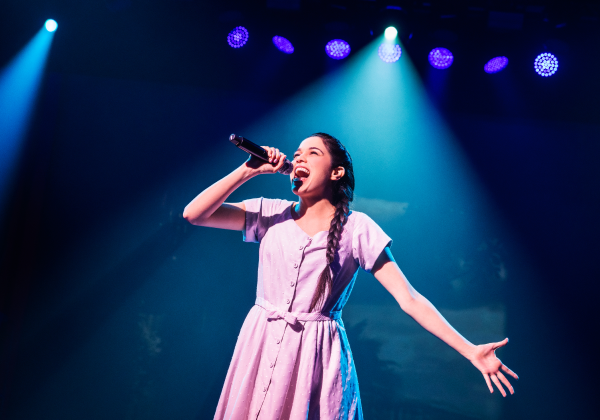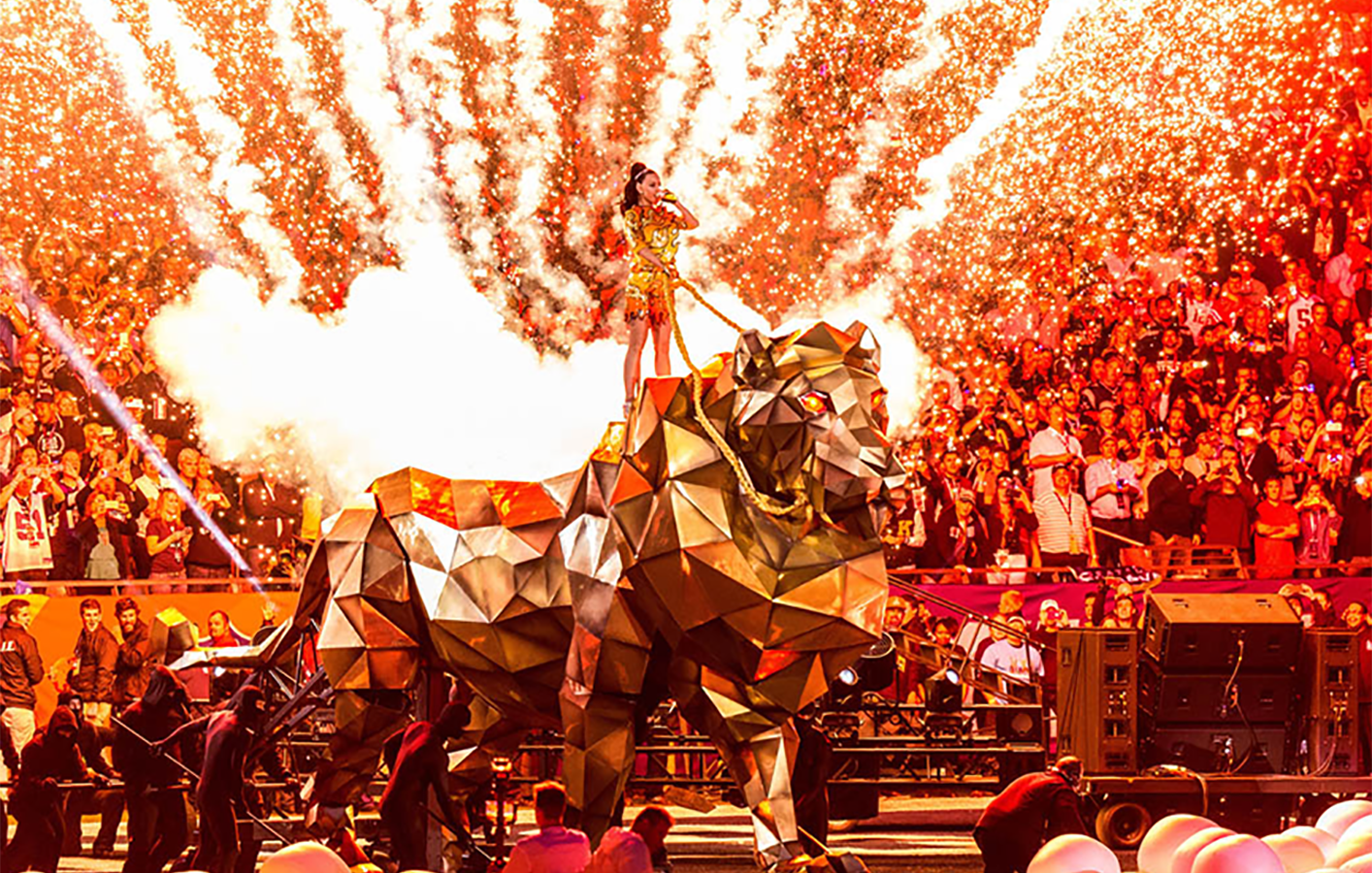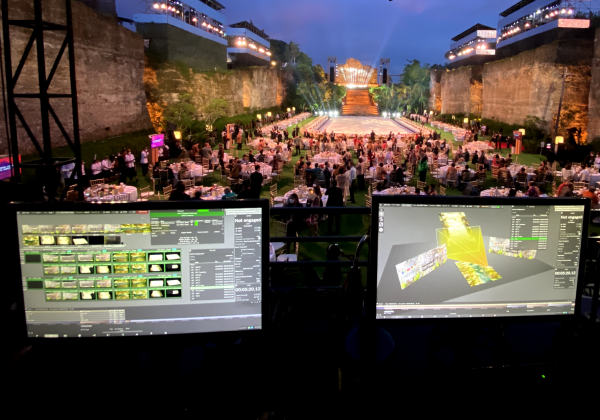
case study 2015 6 min read
Super Bowl XLIX Halftime Show

disguise was used to design, sequence and control the most successful Superbowl halftime show to date.
Viewers of the Super Bowl Halftime Show have come to expect dazzling entertainment, but Katy Perry’s turn at Super Bowl XLIX packed more fun and amazing eye candy into 12 minutes than they might have thought possible. Behind the scenes at the University of Phoenix Stadium in Glendale, Arizona, lighting director Jason Rudolph used eight 4×4pro media servers from disguise to map the football field around the stage with content from 80 Barco projectors. The disguise servers also sent 4 feeds to control the LED stage, magically transforming the floor from a perspective-bending chessboard to a tropical island paradise and a dynamic graphic platform for an airborne finale. VER provided the disguise media servers, grandMA2 control consoles, and all projection and LED gear.
The size and scope of the Super Bowl Halftime Show might seem daunting for some media servers. But last year disguise performed flawlessly at the annual Eurovision Song Contest, a unique competition seen by 180 million TV viewers in 45 countries. So disguise took the Super Bowl’s 118.5 million viewers in stride.
“Super Bowl XLIX was one of the first big American shows run on our award-winning 4×4pro hardware, a very powerful platform,” says Ash Nehru, Technology Director at disguise. “It marked our acceptance by the American market. With Eurovision and the Super Bowl behind us it shows the industry how serious we are about handling projects of this size and complexity.”
Jason Rudolph has deployed disguise media servers on various projects over the years, but thanks to the introduction of SockPuppet DMX in r.11.2 he has increased his disguise usage. SockPuppet enables those who want to tap all disguise mapping, playback and projection features to do so while using their preferred control surface, including most lighting consoles. In Rudolph’s case that meant the grandMA2 light, his desk of choice.
“The disguise media servers were great – and there were a lot of challenges on the Super Bowl,” says Rudolph. “Ash was on site with us and created some custom tools that helped us pull off a show that would have been significantly harder without disguise.”
disguise played a key role in the pre-production process, too. Cincinnati-based Lightborne used a 4×4pro media server from Upstaging, Inc. in Los Angeles to previs the LED animation and projection effects it created for Perry’s performance.
Ben Nicholson, video content director for Lightborne, began using disguise in the pre production process. “I know it’s called a media server, but I see disguise as the world’s greatest simulator,” he says. “Integrated into our workflow it gives us real-time pixel-accurate information about what our content will look like. When you can’t get to the venue until the last minute, it’s important to visualise everything before you get on site.”
Over a three-week period Lightborne mimicked the stadium inside the Los Angeles Memorial Sports Arena using eight projectors to map the basketball arena’s floor to scale.
“We were able to take the CAD image of the stadium and the camera plots and plug them into our 3D file and calculate all the angles,” Nicholson says. “We had the virtual hero camera parked in the disguise system a month ahead of time. When we arrived at the stadium for three days of rehearsals we saw how close to the actual camera we really got: We didn’t have to re-render everything to match the real camera, which was a huge time saver.”
He notes that being able to accurately plot the camera view, including set pieces from the production CAD, turned disguise into “a pre production tool for director Hamish Hamilton and the choreographers, too. They were able to see how the audience would view the show from all angles, and it clarified the whole concept of projection mapping for people who might not have known what it is.”
Nicholson emphasises that using disguise for simulation “really streamlines things. It helps us make intelligent choices about how to create and preview media.”
Back at the stadium Rudolph was taking advantage of the disguise QuickCal calibration feature, a revolutionary way to align projectors on site. QuickCal reduces the time it takes to line up a single projector to just nine minutes. A handy feature when 80 projectors are on hand.
Rudolph explains that when the football field surface was removed and the white fabric projection surface installed it was set at a level three feet lower than the football field. “Using disguise QuickCal function we could walk the area with a couple of tripods, set them to the right height and calibrate the projectors even though the projection surface was not there for most of the first week,” he says. “So we only needed to tweak the calibration a little bit when the projection surface came in.”
He also discovered that the steel structure of the stadium shifted a millimeter or two depending on the position of the stadium’s retractable roof and the temperature of the air. That shift translated into “a couple of inches of movement” for determining the throw of the projectors during the show, and “in terms of alignment, that’s a huge issue” – especially when time is short.
So Nehru devised a custom solution, which enabled technicians Matt Waters and Kris Murray to realign the 80 projectors in four batches. “The second we were given control of the field we got ready to adjust the projectors,” says Rudolph. “We’d grab a quarter of the projectors, nudge them in a certain direction to make sure they were aligned, then grab the next quarter and align them to their companions. Matt and Kris did a heck of a job – in less than seven minutes.”
Rudolph and his team also benefited from the disguise Dynamic Blend feature, which eliminates the need to draw blending masks by hand for all the projectors in the grid. “That probably saved two full days,” estimates Nehru. “We just turned on a switch and the blend was there,” says Rudolph. “It was a big time saver.”
J.T. Rooney of Lightborne was responsible for implementing disguise during rehearsals; Eric Marchwinski of Earlybird Design Inc., Katy Perry’s lighting programmer, ran the disguise from the grandMA2 light during rehearsals. Zak Haywood, disguise Technical Manager, worked with Matt Waters to build the system and was the technical support lead.
Equipment
- Designer
- Find out more
- 4x4pro
- Find out more
Credits
- Lighting Programmer
Eric Marchwinski - Earlybird Design Inc.
- disguise Support Lead
Zak Haywood / Matt Waters





